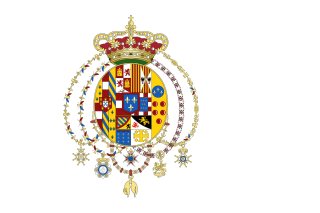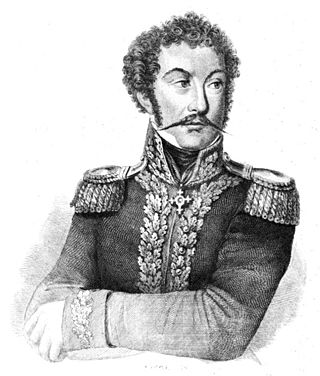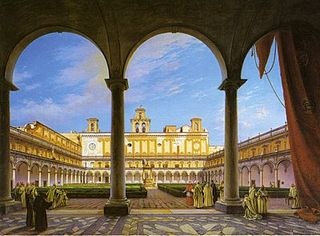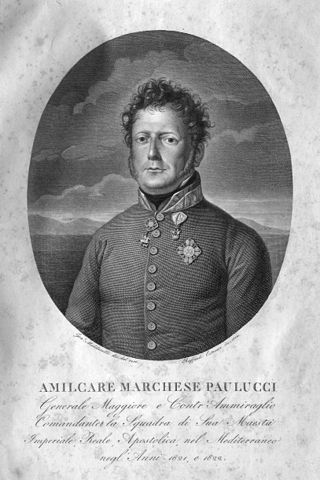
Ferdinand II was King of the Two Sicilies from 1830 until his death in 1859.

Ferdinand I was King of the Two Sicilies from 1816 until his death. Before that he had been, since 1759, King of Naples as Ferdinand IV and King of Sicily as Ferdinand III. He was deposed twice from the throne of Naples: once by the revolutionary Parthenopean Republic for six months in 1799, and again by a French invasion in 1806, before being restored in 1815 at the end of the Napoleonic Wars.

Southern Italy, also known as Meridione or Mezzogiorno, is a macroregion of Italy consisting of its southern regions.

The Sicilian revolution of independence of 1848 which commenced on 12 January 1848 was the first of the numerous Revolutions of 1848 which swept acrosss Europe. It was a popular rebellion against the rule of Ferdinand II of the House of Bourbon, King of the Two Sicilies. Three revolutions against the Bourbon ruled Kingdom of the Two Sicilies had previously occurred on the island of Sicily starting from 1800: this final one resulted in an independent state which survived for 16 months. The Sicilian Constitution of 1848 which survived the 16 months was advanced for its time in liberal democratic terms, as was the proposal of a unified Italian confederation of states. It was in effect a curtain-raiser to the end of the Bourbon kingdom of the Two Sicilies, finally completed by Giuseppe Garibaldi's Expedition of the Thousand in 1860, the Siege of Gaeta of 1860–1861 and the proclamation of the unified Kingdom of Italy.
The Royal Navy is the United Kingdom's navy.

The Order of Saint George of the Reunion is an order of knighthood of the Kingdom of the Two Sicilies. It was established to replace the Royal Order of the Two-Sicilies.
Inno al Re, disputed between Giovanni Paisiello and Pietro Pisani, was a hymn praising King Ferdinand IV of Naples, then Ferdinand I of Two Sicilies, which functioned as the national anthem of the kingdom of the Two Sicilies,.

The Kingdom of the Two Sicilies was a kingdom in Southern Italy from 1816 to 1861 under the control of a cadet branch of the Spanish Bourbons. The kingdom was the largest sovereign state by population and size in Italy before Italian unification, comprising Sicily and most of the area of today's Mezzogiorno in covering all of the Italian Peninsula south of the Papal States.

Giuseppe Maria Rosaroll-Scorza was an Italian essayist and a general in the army of the Kingdom of the Two Sicilies. He was also the father of the Italian patriotic hero Cesare Rosaroll.

The Army of the Two Sicilies, also known as the Royal Army of His Majesty the King of the Kingdom of the Two Sicilies, the Bourbon Army or the Neapolitan Army, was the land forces of the Kingdom of the Two Sicilies, whose armed forces also included a navy. It was in existence from 1734 to 1861. It was the land armed force of the new independent state created by the settlement of the Bourbon dynasty in southern Italy following the events of the War of the Polish Succession.

Giustino Fortunato, also known as Giustino Fortunato senior was an Italian magistrate and politician. His nephew was the Italian historian and politician Giustino Fortunato (1848-1932).

The School of Posillipo refers to a loose group of landscape painters, based in the waterfront Posillipo neighborhood of Naples, Italy. While some among them became academicians, it was not a formal school or association.

Vesuvio was a ship of the line of the Real Marina of the Kingdom of the Two Sicilies, later acquired as a frigate by the Italian Royal Navy. She was initially a French Bucentaure class whose construction began in August 1812, but the works stalled and the ship was transferred to the Kingdom of Naples in 1813.

The Royal Sardinian Navy was the naval force of the Kingdom of Sardinia. The fleet was created in 1720 when the Duke of Savoy, Victor Amadeus II, became the King of Sardinia. Victor Amadeus had acquired the vessels be used to establish the fleet while he was still the King of Sicily in 1713. The Sardinian Navy saw action in a number of conflicts, including the French Revolutionary Wars and the Napoleonic Wars from the 1790s to 1810s, limited actions against the Barbary Coast such as the Battle of Tripoli in 1825, and the Second Italian War of Independence in 1859. The last war was a major step toward Italian unification, which led to the creation of a united Italian state in 1861. During the fighting in 1860, the Royal Navy of the Two Sicilies either defected or surrender and was merged into the Sardinian Navy, resulting in the creation of the Regia Marina, which itself became the Marina Militare, the modern Italian navy, in 1946.

The Marquis Amilcare Ambrosio Paulucci delle Roncole was an aristocrat from Modena, in what is now Italy, who served in the navy of the Bourbon Kingdom of Naples from 1787 to 1799. He then joined the French service during the wars of the French Revolution and the First French Empire. He served in the Parthenopean Republic, the Cisalpine Republic and the Kingdom of Italy. While commanding a squadron in the Adriatic in 1808 he was captured by the British, and held until 1812. He joined the army in 1813 and served in the expedition against Austria, where he was wounded. When the French Empire collapsed in 1814 he helped arrange the transfer of officers and troops in Italy to the Austrian army. He became a major general in the Austrian army in July 1814. In 1818 he again became involved in naval affairs, and in 1824 became commander in chief of the Austrian navy based in Venice, a position he held until 1844.
The Bank of the Tavoliere di Puglia (1835–1845) was a bank located in the city of Foggia, in the Kingdom of the Two Sicilies. Its purpose was to foster the development of the so-called Tavoliere delle Puglie, one of the poorest areas of the Kingdom of the Two Sicilies, but its hidden purpose was probably to defraud Mr. Van-Aken, an investor from Bruxelles who was planning to invest about two million ducats in the Kingdom of the Two Sicilies on behalf of Dutch and Belgian bankers. As stated by Italian economist Luca de Samuele Cagnazzi, the purpose of all the banks in the Kingdom of the Two Sicilies was to commit some kind of bankruptcy fraud, leading to serious harm to the economy of the kingdom, and this was exacerbarted by widespread corruption in the field of justice.

Enrico Di Brocchetti, Baron was an Italian admiral and politician, Senator of the Kingdom of Italy, and Minister of the Navy in the first Cairoli government.

Marquis Orazio Di Negro was an Italian politician and admiral, who served as Minister of the Navy of the Kingdom of Italy in the Farini and first Minghetti governments.
















